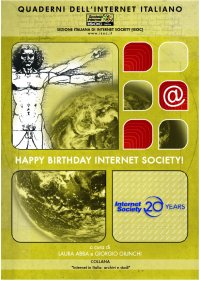- In the
field of IT networks Italy has always played a leading role at international
level.
- At the
beginning, as in many other countries, the situation was rather fragmented
and by the late 70s several different networks had already been developed
within the research sector.
- In 1978
RPCnet, the CNR network became operational; 1979 INFNet, the network of
nuclear physics and in 1984 the National University Network (RNU) was presented,
connecting all universities involved in calculation programming (CILEA,
CINECA, CSATA). However, each of these networks spoke its own language
because they all used different protocols which made any kind of inter-network
collaboration difficult.
- The first
intercontinental connections between different network types was made thanks
to satellite communications, between the UK and Norway in 1977.
- Italy
was the third European country, in 1986, to connect a network node to ARPANET,
thanks to CNUCE, a CNR institute in Pisa, which established the connection
through an agreement with Italcable and Telespazio.
- At that
time the European Academic and Research Network (EARN) was just being set
up, a continental version of the American inter-university network BITNET,
which facilitated use of the network for scholastic and research purposes
and stimulated the growth of a uniform community of users. Italy was the
first country to connect to BITNET.
- The experience
of the first networks connecting different groups demonstrated all too
soon that the individual networks alone could not continue as before: too
expensive and inadequate to ensure the exchange of inter-disciplinary data
necessary to research.
- It was
time to share resources and experiment jointly.
- Given
the growing use of telecommunications networks to exchange information,
researchers soon realized that the creation of channels that were faster,
reliable, and above all interoperable would be the vital prerequisite for
future research.
- At an
economic level, it was obvious that duplicating resources and time for
a whole range of incompatible networks for each individual field of application
or private interest group was not the route ahead.
- Against
this background, the European Commission began to define more long term
objectives and launched the EUREKA programme to support projects for innovation
and R&D in all technological sectors.
- One such
project within the programme was COSINE (Cooperation for Open Systems Interconnection
in Europe), aimed at promoting co-operation among researchers in Europe
and promoting development of open networks and the use of a non-proprietary
protocol such as OSI.
- COSINE
(1985-1993), in particular, aimed to set up a single network within the
European research scenario and to achieve this every country would need
to begin a process of harmonization of the existing national level networks.
- Given
the European encouragement, the minister for Scientific Research Mr. Granelli
and his successor Antonio Ruberti, with the delegate for EUREKA projects,
Orio Carlini, began to lay the basis for Italian participation in a common
European network, calling a meeting of the key players in the national
IT networks, who began the work of integrating their different systems.
- So it
was that in 1986, during one of the preliminary meetings that the word
GARR was pronounced for the first time: Gruppo per L'Armonizzazione delle
Reti della Ricerca.
- A formal
request was then submitted to Minister Ruberti for constitution of this
workgroup, by the 6 founding bodies: CNR, INFN, ENEA, CILEA, CINECA, Tecnopolis
CSATA.
- The request
was granted and GARR, initially formed as spontaneous workgroup, was formally
established as a ministerial commission under a decree passed on 11 March
1988.
- The commission,
chaired by Prof. Orio Carlini, immediately began working on the infrastructure
of the national network, using the funds for infrastructure investment
assigned in that year's budget to the Ministry of Scientific Research (50
billion Lire were allocated to calculation and network projects).
- In addition
to the creation of a single unifying network, GARR also worked to extend
and integrate network services, rationalizing expenses and harmonizing
development policies.
- At an
international level, Garr's contributions included significant co-ordination
in relation to European networks and promotion of scientific collaboration.
- The new
unified network sparked a fruitful season of technological innovation in
the networking sector, thanks to the constant labour and spirit of collaboration
of all players involved.
|
![]()
![]()
![]()
